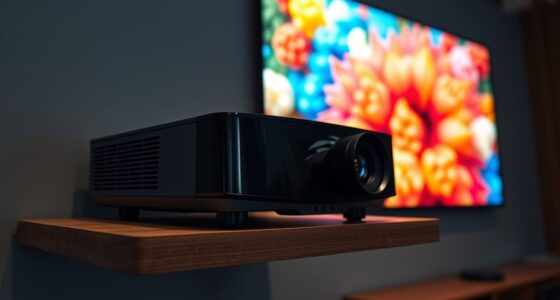Understanding color gamut and coverage helps you see how devices reproduce colors accurately and consistently. Gamut refers to the range of colors a device can display or print, with wider gamuts offering richer, more vibrant images. Measurement involves models like sRGB or Adobe RGB, which define standards for color reproduction. If you want to learn how to check, compare, and improve your device’s color fidelity, you’ll find useful tips and insights ahead.
Key Takeaways
- Color gamut defines the range of colors a device can reproduce, affecting vibrancy and accuracy.
- Broader gamuts like Adobe RGB or DCI-P3 capture more colors than sRGB, enhancing visual quality.
- Gamut coverage is measured using color space models and volume metrics to compare device capabilities.
- Visual gamut mapping helps identify color gaps and overlaps across devices, ensuring consistent color reproduction.
- Proper calibration and color management are essential for maintaining color fidelity and maximizing gamut coverage.
What Is Color Gamut and Why Does It Matter?
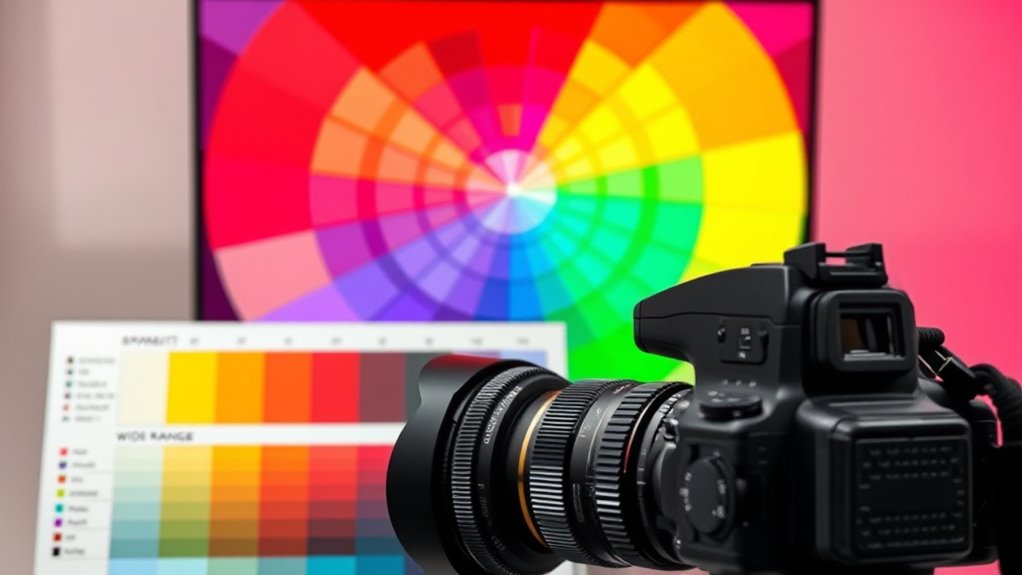
Understanding what color gamut is helps you grasp why display quality varies. Essentially, color gamut describes the range of colors a device can reproduce. The wider the gamut, the more vibrant and accurate colors appear, which directly impacts your color perception. If your display has a limited gamut, images might look dull or washed out, affecting how you experience photos, videos, or artwork. For artists and designers, a broad color gamut allows for richer artistic expression, enabling detailed and true-to-life color work. It’s not just about aesthetics—accurate colors influence how you interpret and enjoy visual content. Knowing about color gamut helps you choose devices that match your needs, whether for professional creative work or simply enjoying more vivid images. Additionally, understanding color accuracy can help you select displays that provide consistent and true-to-life colors across different applications.
How Color Gamut Is Measured and Represented
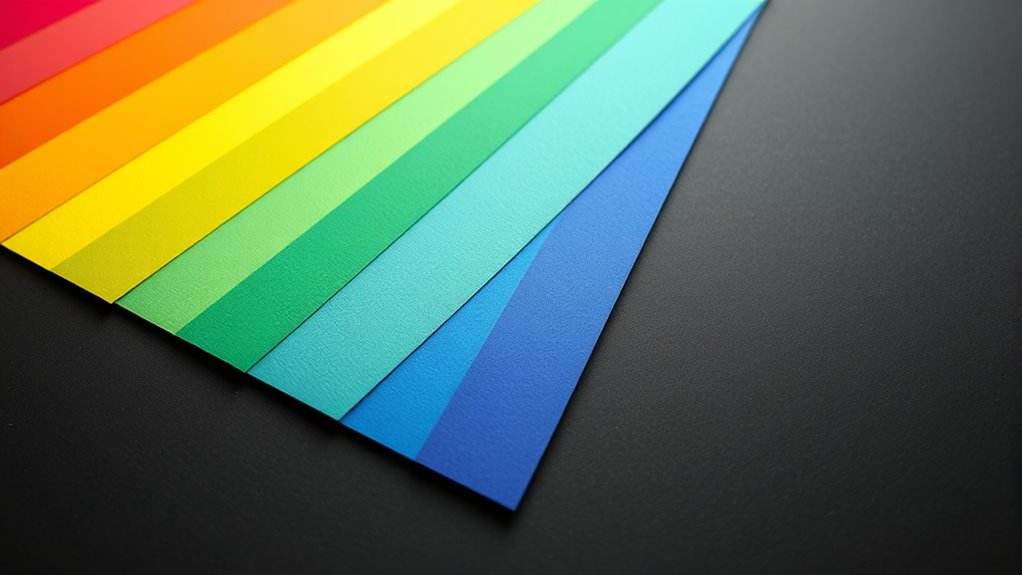
To understand how color gamut is measured and represented, you need to explore color space models like sRGB or Adobe RGB. These models help quantify a device’s color capabilities using metrics such as gamut volume. Visual gamut mapping then allows you to compare and interpret these measurements across different devices or standards.
Color Space Models
Color space models serve as the foundation for representing and measuring color gamuts, providing a standardized way to define and compare how colors are displayed across different devices. These models translate color perception into numerical values, making it easier to understand and reproduce colors consistently. They help you grasp the relationship between colors and how they can be used for artistic expression. By understanding color space models, you can select the right one for your needs, whether for digital design or printing. Key points include:
- Different models, like RGB and CMYK, suit various applications.
- They define how colors are represented mathematically.
- They enable accurate color communication across devices.
- Vetted models like the Flat Iron Bike also demonstrate how color representations can be applied in real-world product design.
Mastering color space models guarantees you can manipulate and communicate colors effectively, enhancing your creative work.
Gamut Volume Metrics
Gamut volume metrics provide a quantitative way to measure and compare the size of different color gamuts. They help you understand the range of colors a device can reproduce, which is essential for effective color calibration and maintaining color consistency across devices. These metrics typically involve calculating the three-dimensional volume of a color gamut within a color space, such as CIE XYZ or Lab. By evaluating this volume, you can determine how much color space a device covers relative to a standard, like sRGB or Adobe RGB. This measurement allows you to identify gaps in color reproduction and guarantee consistent output. Ultimately, understanding gamut volume metrics helps you optimize your workflow, achieve more accurate color calibration, and maintain reliable color consistency across multiple devices.
Visual Gamut Mapping
Visual gamut mapping involves translating the complex, three-dimensional data of a device’s color capabilities into understandable representations. It helps you see how a device’s color range compares to others, emphasizing perceptual accuracy. This process uses color mapping techniques to visually depict which colors a device can reproduce and how accurately. You’ll often encounter tools like chromaticity diagrams and 2D projections that simplify the data. Additionally, understanding the 1st Home Theatre Projector can help optimize color coverage for immersive viewing experiences.
Key aspects include:
- Highlighting differences in color coverage between devices
- Ensuring perceptual accuracy so colors appear consistent across mediums
- Making it easier to identify color gaps and overlaps in the gamut
Common Color Gamut Standards and Their Differences
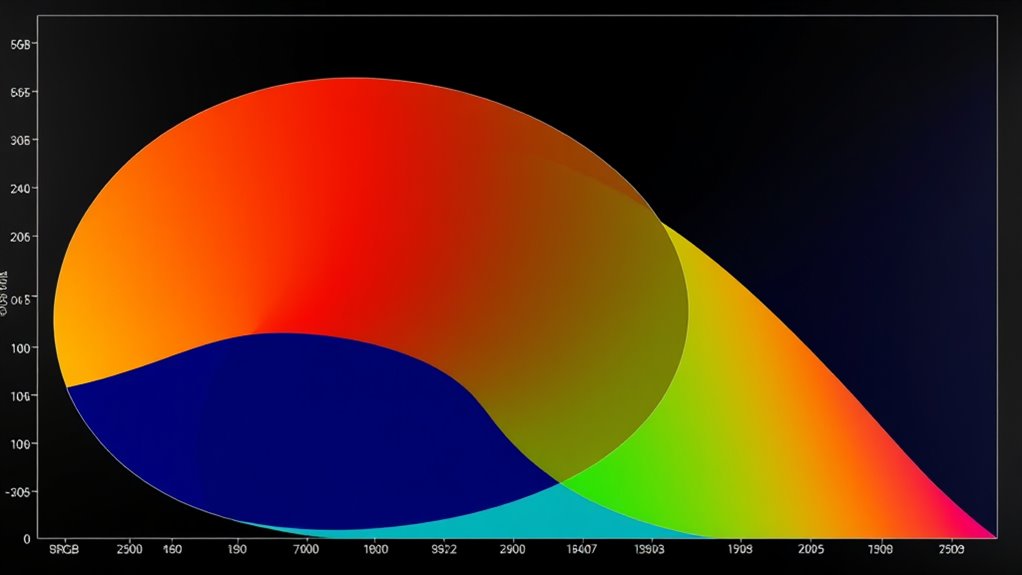
You’ll notice that different color standards like sRGB and Adobe RGB serve specific purposes, with varying coverage of the visible spectrum. Understanding how DCI-P3 compares to BT.2020 helps you choose the right standard for digital cinema or ultra-high-definition content. Recognizing the difference between coverage and gamut range clarifies how devices reproduce colors accurately. Additionally, being aware of eco-friendly crafting practices can inspire sustainable choices in your creative projects.
Srgb Vs Adobe RGB
When choosing between color standards, understanding the differences between sRGB and Adobe RGB is essential, as they represent two of the most widely used color gamuts in digital imaging. sRGB is the standard for most screens and online content, offering good color consistency across devices. Adobe RGB covers a wider color spectrum, especially in greens and blues, making it ideal for professional photo editing and color grading.
- sRGB is simpler for consistent color calibration across devices
- Adobe RGB provides more vibrant colors for print and high-quality images
- Your choice impacts how colors appear during editing and display
- Incorporating color gamut standards can help optimize your workflow and output quality
Knowing these differences helps you select the right standard for your workflow, ensuring accurate color reproduction and better results in your projects.
DCI-P3 Vs BT.2020
DCI-P3 and BT.2020 are two prominent color gamuts used in digital cinema and high-definition displays, each covering different ranges of the color spectrum. DCI-P3 offers a wider color space than sRGB, focusing on cinematic color accuracy with vibrant reds and greens. BT.2020, or Rec. 2020, expands even further, encompassing nearly the entire visible spectrum for ultra-high-definition content, ensuring exceptional color accuracy. The table below compares these standards:
| Feature | DCI-P3 | BT.2020 |
|---|---|---|
| Primary Colors | Red, Green, Blue | Red, Green, Blue |
| Coverage | ~45% of Rec. 2020 | Nearly 100% of visible spectrum |
| Use Case | Digital cinema, HDR | 4K/8K UHD, HDR |
| Color Space Type | Wide Gamut | Ultra Wide Gamut |
| Focus | Cinematic color accuracy | Future-proof high dynamic range |
Choose wisely for prime color precision. Additionally, understanding the color gamut standards helps content creators optimize visual performance across devices.
Coverage Vs Gamut Range
Understanding the difference between a color gamut’s coverage and its range is key to choosing the right standard for your display needs. Coverage refers to how much of a specific color space a device can reproduce, while gamut range indicates the full spectrum of colors a standard can display. Higher coverage often means better color accuracy, especially after proper display calibration. Keep in mind that color depth also impacts how vivid those colors appear. When comparing standards, look at how much of the desired color space they cover and whether your display can handle the full gamut range. For ideal results, confirm your display is calibrated correctly to match the intended color standards. This ensures maximum coverage, vibrant colors, and consistent performance across different devices. Additionally, understanding color calibration can further optimize your display performance.
Understanding Color Coverage and Its Significance
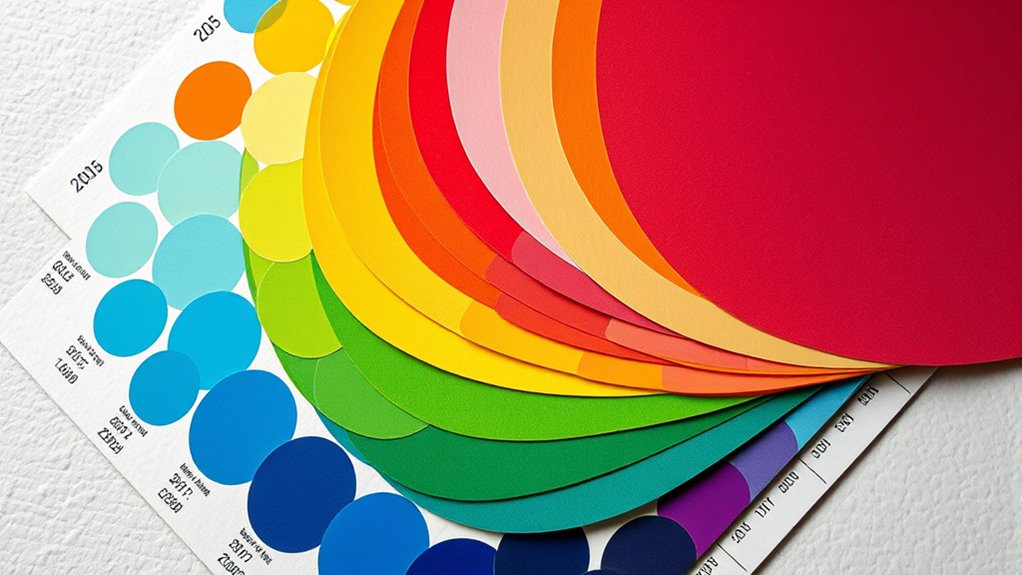
Color coverage defines the range of colors a display or printer can reproduce, which directly impacts the vibrancy and accuracy of the images you see. When coverage is broad, your device can showcase more nuanced shades, enhancing color perception and making images appear more lifelike. Understanding this helps you appreciate how color choices influence mood and perception—key aspects of color psychology. For designers and photographers, high coverage ensures their work looks consistent across different mediums. For consumers, it means richer, more vivid visuals. Recognizing the significance of color coverage helps you select devices that match your needs, whether for professional editing, casual viewing, or artistic expression. Additionally, a greater color gamut allows for more precise color matching, which is crucial in fields like printing and digital art. Ultimately, it’s about guaranteeing your visuals communicate precisely what you intend, with clarity and emotional impact.
Comparing Gamut Coverage Across Devices and Mediums

When comparing gamut coverage across devices and mediums, it’s essential to recognize that not all displays or printers can reproduce the same range of colors. Differences often stem from device calibration and the quality of color profiling. To accurately compare, guarantee each device is properly calibrated, so color consistency is maintained. Keep in mind:
Ensuring proper calibration and profiling is key to accurate color gamut comparison across devices and mediums.
- Some screens may display a wider color gamut than others, affecting visual accuracy.
- Printers with advanced color profiling can reproduce more vibrant and true-to-life colors.
- Medium-specific limitations can restrict color reproduction, regardless of calibration.
- Understanding the science of color gamuts helps in making more precise assessments of device capabilities.
Understanding these factors helps you identify gaps in color coverage. It also highlights the importance of proper device calibration and precise color profiling to make meaningful comparisons across different equipment and mediums.
How to Check the Gamut Coverage of Your Equipment

To check the gamut coverage of your equipment, start by using specialized software or calibration tools designed for this purpose. These tools help you measure how much of the color spectrum your device can reproduce. Calibration techniques are essential here; they ensure your display or printer accurately aligns with standard color spaces, improving color management. Begin with a calibration process to create an accurate profile, then use color management software to compare your device’s output against target gamuts like sRGB or Adobe RGB. Many calibration tools include built-in options to visualize and quantify your device’s coverage. Regularly performing these checks helps you identify limitations and maintain consistent color accuracy across projects. Proper calibration and understanding of your equipment’s gamut coverage are crucial for reliable, predictable color reproduction, especially when working with color management in professional workflows.
Tips for Working Within Color Gamut Limitations
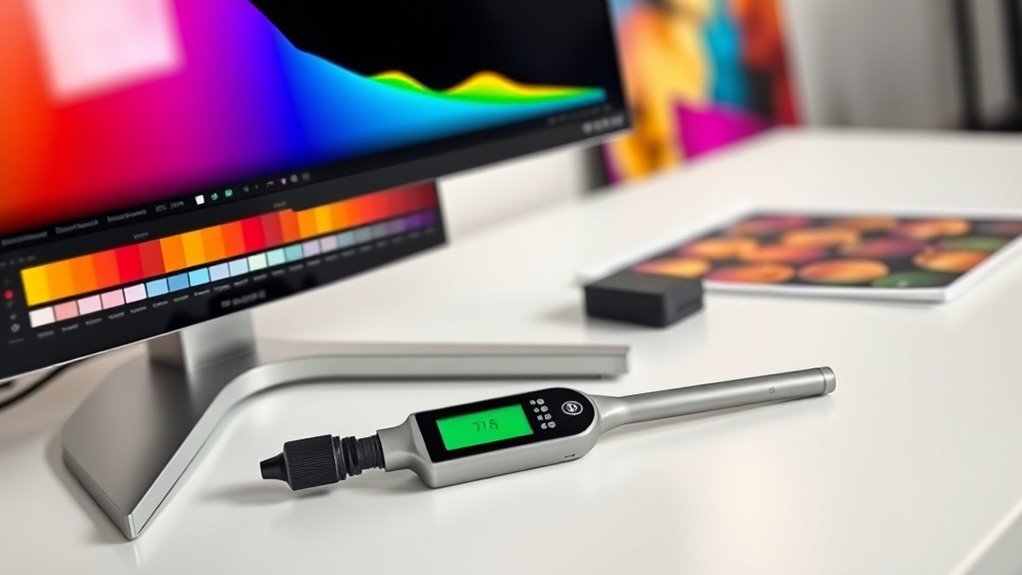
Working within the limitations of your device’s color gamut requires a strategic approach to guarantee your images remain vibrant and accurate. Start by understanding your device’s color space, so you know its boundaries. Proper color calibration ensures your display or printer accurately reproduces colors and reduces discrepancies. To optimize your workflow:
Master your device’s color space and calibration to keep images vibrant and true to life.
- Soft-proof your images to preview how colors will appear within your device’s color space.
- Use color management tools to maintain consistent color calibration across devices.
- Avoid highly saturated colors that fall outside your device’s gamut, and adjust them subtly for better accuracy.
Improving Color Fidelity Through Gamut Management
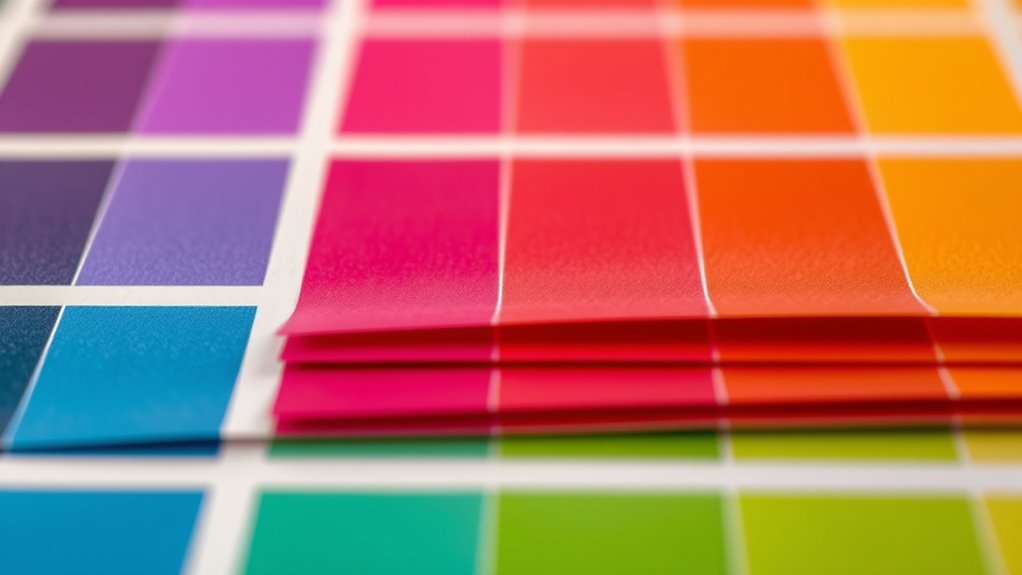
Effective gamut management plays a key role in enhancing color fidelity across your devices. By implementing proper color calibration, you guarantee consistent and accurate colors, no matter the display or printer. Color management helps you align devices so they interpret and reproduce colors similarly, reducing discrepancies. Regular calibration adjusts your monitor’s settings to match a standard color profile, maintaining fidelity over time. When you manage your gamut effectively, you minimize color shifts and improve overall image quality. This process also helps you identify and address limitations in your display’s coverage, ensuring your colors are as precise as possible. Ultimately, disciplined gamut management keeps your workflow consistent, making your colors reliable from creation to final output.
Frequently Asked Questions
How Does Ambient Lighting Affect Color Gamut Perception?
Ambient lighting profoundly impacts how you perceive color gamut. When your ambient light is bright, it can wash out colors, making them seem less vibrant and reducing your eye perception of a display’s true color range. Conversely, dimmer ambient light enhances contrast and color richness, allowing your eye perception to better grasp the full gamut. So, adjusting ambient light helps you see colors more accurately and vividly.
Can Color Gamuts Be Expanded Beyond Standard Device Capabilities?
They say “you can’t teach an old dog new tricks,” but when it comes to color gamuts, you actually can expand beyond standard device capabilities through gamut extension. By leveraging advanced color management techniques, you push the boundaries of your display’s color range. This process involves calibrating and optimizing your device to better capture and reproduce colors, ensuring you get the most vibrant, accurate visuals possible.
What Role Does Calibration Play in Maintaining Accurate Color Coverage?
Calibration plays a pivotal role in maintaining accurate color coverage by ensuring your device produces consistent and true-to-life colors. When you perform regular color calibration, you improve color consistency across different screens and prints, reducing discrepancies. This process aligns your device’s output with standard color profiles, helping you achieve reliable and precise color reproduction, whether you’re editing photos or preparing designs for print.
Are There Industry-Specific Color Gamut Requirements?
When it comes to industry-specific color gamut requirements, you need to remember that standards vary across sectors like fashion, automotive, and printing. These standards ensure branding consistency and precise color reproduction. While some industries demand a wider color gamut for vibrant visuals, others prioritize accuracy. It’s crucial to stay updated on industry standards to avoid putting your foot in your mouth and to keep your brand’s colors consistent and spot-on across all platforms.
How Does Color Gamut Influence Print Versus Digital Color Accuracy?
Color gamut greatly influences print versus digital color accuracy because it involves understanding color space nuances and the viewing environment. In print, you deal with a smaller color gamut, leading to potential color shifts if not managed properly. Digital displays, however, often have a wider gamut, but colors can appear different depending on lighting and device calibration. Knowing these factors helps you guarantee consistent, accurate colors across both mediums.
Conclusion
Now that you understand color gamut and coverage, you hold the brush to paint your visual world with confidence. Think of your devices as a vibrant palette—knowing their limits helps you avoid muddy colors and keeps your images crisp and true. Mastering gamut management is like tuning a musical instrument, ensuring every note shines perfectly. With this knowledge, you’re ready to craft visuals that dance with brilliance and stay true to your creative vision.



